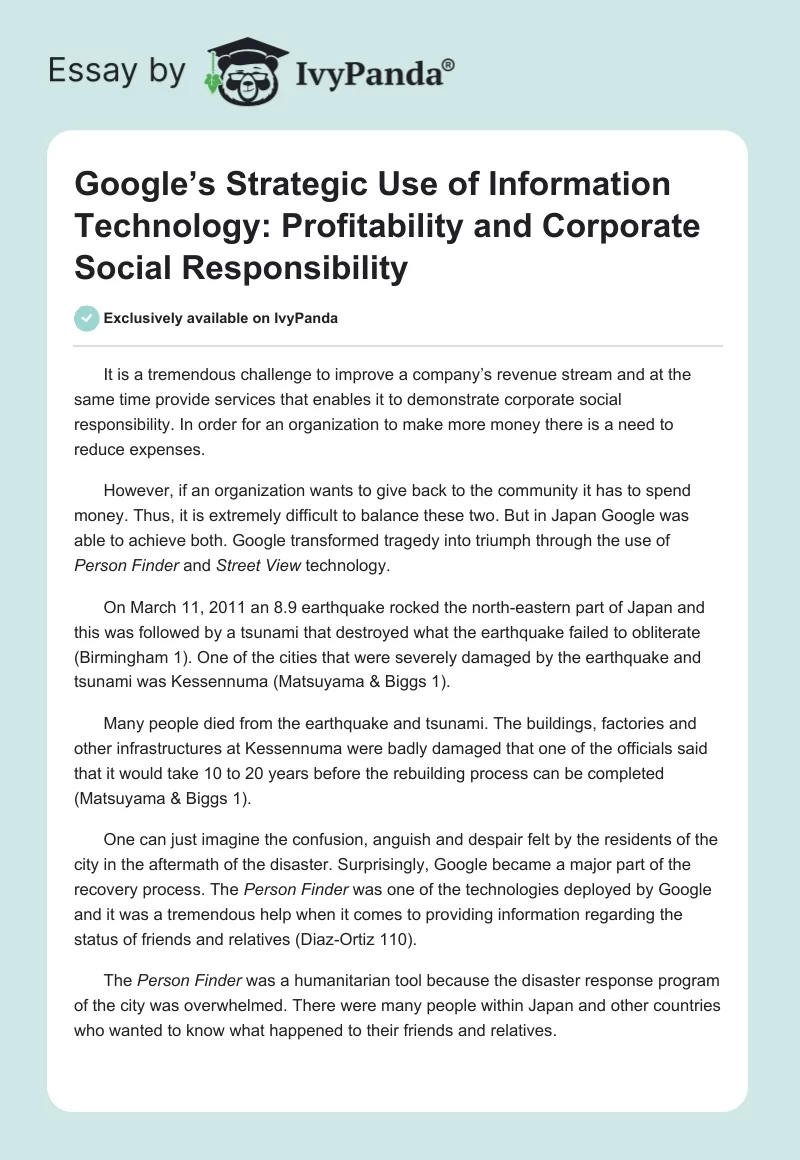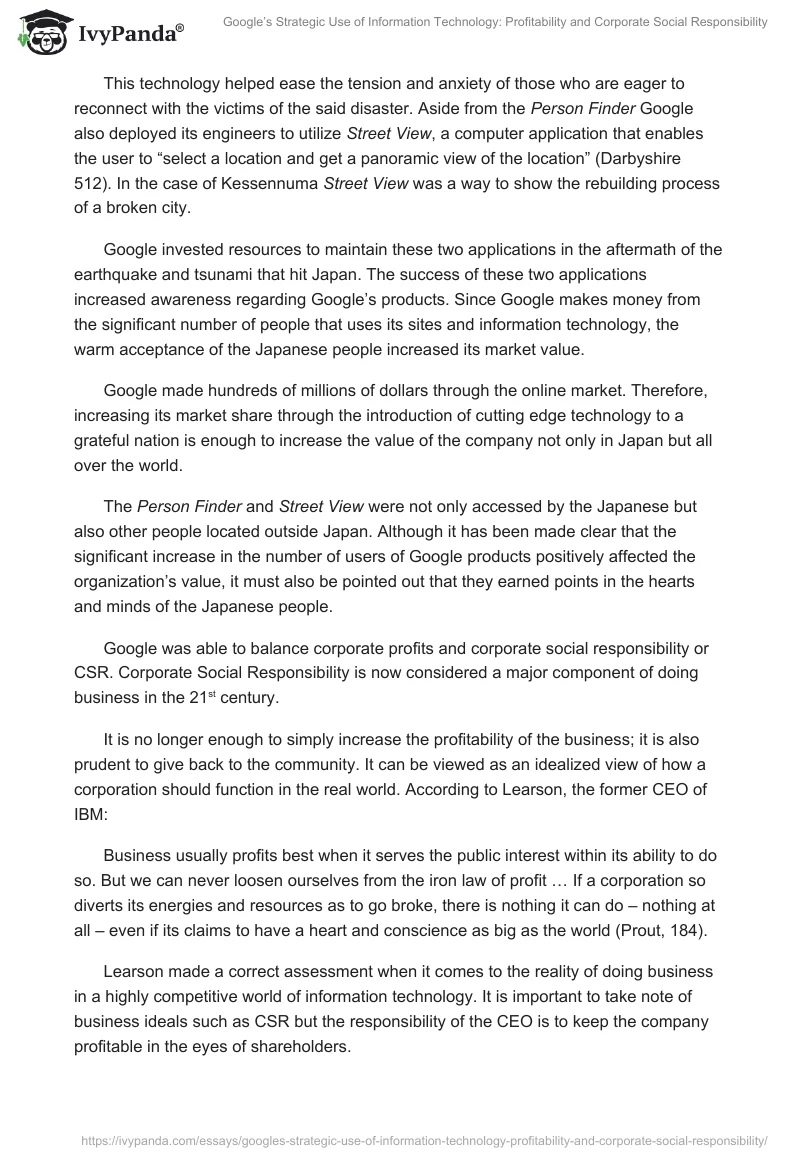It is a tremendous challenge to improve a company’s revenue stream and at the same time provide services that enables it to demonstrate corporate social responsibility. In order for an organization to make more money there is a need to reduce expenses.
However, if an organization wants to give back to the community it has to spend money. Thus, it is extremely difficult to balance these two. But in Japan Google was able to achieve both. Google transformed tragedy into triumph through the use of Person Finder and Street View technology.
On March 11, 2011 an 8.9 earthquake rocked the north-eastern part of Japan and this was followed by a tsunami that destroyed what the earthquake failed to obliterate (Birmingham 1). One of the cities that were severely damaged by the earthquake and tsunami was Kessennuma (Matsuyama & Biggs 1).
Many people died from the earthquake and tsunami. The buildings, factories and other infrastructures at Kessennuma were badly damaged that one of the officials said that it would take 10 to 20 years before the rebuilding process can be completed (Matsuyama & Biggs 1).
One can just imagine the confusion, anguish and despair felt by the residents of the city in the aftermath of the disaster. Surprisingly, Google became a major part of the recovery process. The Person Finder was one of the technologies deployed by Google and it was a tremendous help when it comes to providing information regarding the status of friends and relatives (Diaz-Ortiz 110).
The Person Finder was a humanitarian tool because the disaster response program of the city was overwhelmed. There were many people within Japan and other countries who wanted to know what happened to their friends and relatives.
This technology helped ease the tension and anxiety of those who are eager to reconnect with the victims of the said disaster. Aside from the Person Finder Google also deployed its engineers to utilize Street View, a computer application that enables the user to “select a location and get a panoramic view of the location” (Darbyshire 512). In the case of Kessennuma Street View was a way to show the rebuilding process of a broken city.
Google invested resources to maintain these two applications in the aftermath of the earthquake and tsunami that hit Japan. The success of these two applications increased awareness regarding Google’s products. Since Google makes money from the significant number of people that uses its sites and information technology, the warm acceptance of the Japanese people increased its market value.
Google made hundreds of millions of dollars through the online market. Therefore, increasing its market share through the introduction of cutting edge technology to a grateful nation is enough to increase the value of the company not only in Japan but all over the world.
The Person Finder and Street View were not only accessed by the Japanese but also other people located outside Japan. Although it has been made clear that the significant increase in the number of users of Google products positively affected the organization’s value, it must also be pointed out that they earned points in the hearts and minds of the Japanese people.
Google was able to balance corporate profits and corporate social responsibility or CSR. Corporate Social Responsibility is now considered a major component of doing business in the 21st century.
It is no longer enough to simply increase the profitability of the business; it is also prudent to give back to the community. It can be viewed as an idealized view of how a corporation should function in the real world. According to Learson, the former CEO of IBM:
Business usually profits best when it serves the public interest within its ability to do so. But we can never loosen ourselves from the iron law of profit … If a corporation so diverts its energies and resources as to go broke, there is nothing it can do – nothing at all – even if its claims to have a heart and conscience as big as the world (Prout, 184).
Learson made a correct assessment when it comes to the reality of doing business in a highly competitive world of information technology. It is important to take note of business ideals such as CSR but the responsibility of the CEO is to keep the company profitable in the eyes of shareholders.
It has been said that to give is better than to receive but this is not the practical view of most businessmen. Learson is one of those astute business people who understood that if a CEO no longer cares about the bottom line then the organization is in peril. It is imperative to maintain a steady stream of revenue because if the company shuts down then it can no longer help others.
CSR is demonstrated through a determined effort on the part of corporate leaders and employees when it comes to increasing efforts that would lead to a better product and service. The value added to the organization does not come in the form of monetary gain but through positive public relations.
The press will get hold of the information and the company enjoys free advertising. In the 21st century the importance of CSR is highlighted by the fact that many people are online and uses a variety of social networking tools to connect and interact. Imagine the positive impact of a good deed caught on TV or a mobile phone camera. The information can immediately spread spontaneously and travel to many parts of the world.
A study was made on companies that adhere to the principles of CSR and these business organizations were never disappointed (Orlitzky 403). In this particular study, it was discovered that “corporate virtue in the form of social responsibility and, to a lesser extent, environmental responsibility is likely to pay-off” (Orlitzky 403).
The positive feedback from customers and people who directly benefited from the services provided by the organization can translate to customer loyalty. In addition the investors are attracted through the positive public relations generated by the said activity.
Google’s deployment of Person Finder and Street View goes beyond the need to give back to the community. It is interesting to note that Google need not build from scratch when it decided to help the survivors of the March 2011 earthquake and tsunami.
Even before the incident occurred, Google was already developing these types of technology. Therefore, Google was one of the few organizations that was able to maximize its resources to increase its profitability but at the same time remained true to the ideals of CSR. Google was at the right place at the right time with the right tools.
A review of Google’s activities in Japan in the aftermath of the disaster that crippled the north-eastern part of the city is a revelation on how to carefully balance profits and helping people.
Google’s approach to the problem is a perfect example to what experts in CSR had been saying for a very long time, which is: “Doing the most good for your company and your cause” (Kotler & Lee, 10).
Google completely understood the suggestion made by another IT expert when it comes to CSR: “that cutting-edge innovation and competitive advantage can result from weaving social and environmental considerations into business strategy from the beginning” (Kotler & Lee, 18).
Thus, it is important to use setbacks and problems as stepping stones to greater achievements. The world saw despair but Google saw opportunity.
Conclusion
In the aftermath of a disaster Google was able to do something that was extremely difficult to achieve. Google was able to increase its market share in the competitive world of online marketing while at the same time help those who are in need.
Corporate leaders always talk about the need to give back to the community. But in reality it is easier said than done because CSR requires spending money, an activity that CEOs are not keen on doing. But Google was at the right place at the right time with the right tools.
The company was able to maximize its resources in order to help others while at the same time increase it market value. CSR became an important part of the strategy to develop cutting-edge technology and at the same time improve the image of Google in Japan and all over the world.
Works Cited
Birmingham, Lucy. Japan Rocked by Magnitude 8.9 Quake, Tsunami. Time Magazine, 11 Mar. 2011. Web.
Darbyshire, Paul. Getting Started with Google Apps. New York, Springer, 2010. Print.
Diaz-Ortiz, Claire. Twitter for Good: Change the World One Tweet at a Time. New Jersey: John Wiley & Sons, 2011. Print.
Kotler, Philip and Nancy Lee. Corporate Social Responsibility: Doing the Most Good for your Company and your Cause. New Jersey: John Wiley & Sons, Inc., 2005. Print.
Matsuyama, Kanoko and Stuart Biggs. Tsunami Towns Face ‘Empty Monument’ Risk as Japan Rebuilds. Bloomberg, 27 Apr. 2011. Web.
Orlitzky, Marc. “Corporate Social and Financial Performance: A Meta-analysis. Organization Studies 24.3 (2003): 403-441. Print.
Prout, Jerry. “Corporate Responsibility in the Global Economy: A Business Case. Society and Business Review 1.2 (2006): 184-191. Print.


